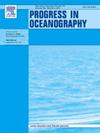Ocean circulation drives zonation of deep-water coral communities and their traits in the Northwest Atlantic
IF 3.6
3区 地球科学
Q1 OCEANOGRAPHY
引用次数: 0
Abstract
One of the main objectives of community ecology is to unravel the mechanisms that influence the composition of species assemblages, a process known as community assembly. While research in terrestrial and coastal marine ecosystems has provided extensive knowledge on community assembly, little is known about the processes that shape ecological communities in the deep sea. In this study, we focus on deep-water coral communities in the NW Atlantic to assess the importance of environmental variables and coral traits for community assembly, by using joint species distribution modelling and trait-based approaches. We found that oceanographic variables, such as bottom temperature and salinity, influence the composition and trait characteristics of deep-water coral communities. Model predictions revealed a bathymetric zonation of coral communities driven by the predominant water masses in the region. Coral skeletal material emerged as an important trait: increased bottom salinity associated with subtropical water masses promoted the occurrence of corals with aragonite-based skeletons, while low salinity associated with subarctic water masses promoted the occurrence of corals that use calcite. Coral communities located at sites influenced by subtropical water masses showed higher species and trait diversity, while communities within the Gulf of Maine showed signs of strong environmental filtering and disturbance. These results emphasize the importance of ocean circulation for the assembly of deep-water coral communities. Our findings advance our understanding of the mechanisms that influence community assembly in the deep sea and improve our ability to predict potential consequences of future shifts in ocean circulation caused by climate change.
海洋环流驱动了西北大西洋深水珊瑚群落的分区及其特征
群落生态学的主要目标之一是揭示影响物种组合组成的机制,这一过程被称为群落组合。虽然对陆地和沿海海洋生态系统的研究提供了关于群落聚集的广泛知识,但对形成深海生态群落的过程知之甚少。在这项研究中,我们以西北大西洋的深水珊瑚群落为研究对象,通过联合物种分布模型和基于特征的方法来评估环境变量和珊瑚特征对群落聚集的重要性。我们发现,海底温度和盐度等海洋变量影响着深水珊瑚群落的组成和特征特征。模型预测揭示了该地区主要水体驱动的珊瑚群落的等深带。珊瑚骨骼材料作为一个重要特征出现:与亚热带水团相关的底部盐度增加促进了文石基骨骼的珊瑚的出现,而与亚北极水团相关的低盐度促进了使用方解石的珊瑚的出现。受亚热带水团影响的珊瑚群落表现出较高的物种和性状多样性,而缅因湾内的珊瑚群落则表现出强烈的环境过滤和干扰迹象。这些结果强调了海洋环流对深水珊瑚群落聚集的重要性。我们的发现促进了我们对影响深海群落聚集的机制的理解,并提高了我们预测气候变化引起的未来海洋环流变化的潜在后果的能力。
本文章由计算机程序翻译,如有差异,请以英文原文为准。
求助全文
约1分钟内获得全文
求助全文
来源期刊

Progress in Oceanography
地学-海洋学
CiteScore
7.20
自引率
4.90%
发文量
138
审稿时长
3 months
期刊介绍:
Progress in Oceanography publishes the longer, more comprehensive papers that most oceanographers feel are necessary, on occasion, to do justice to their work. Contributions are generally either a review of an aspect of oceanography or a treatise on an expanding oceanographic subject. The articles cover the entire spectrum of disciplines within the science of oceanography. Occasionally volumes are devoted to collections of papers and conference proceedings of exceptional interest. Essential reading for all oceanographers.
 求助内容:
求助内容: 应助结果提醒方式:
应助结果提醒方式:


